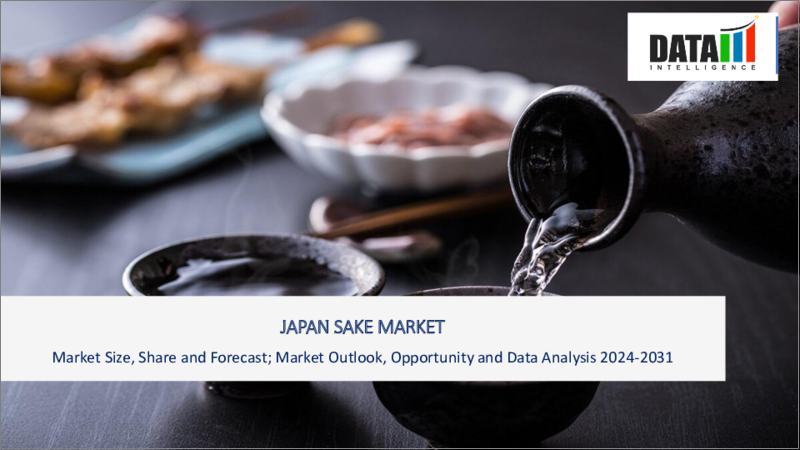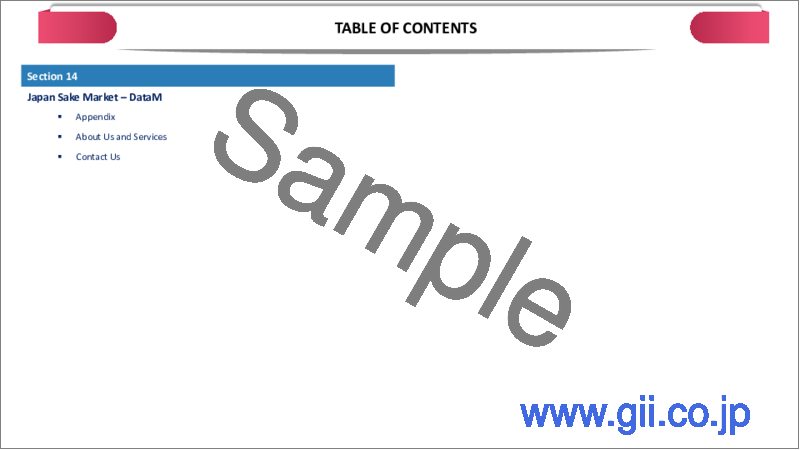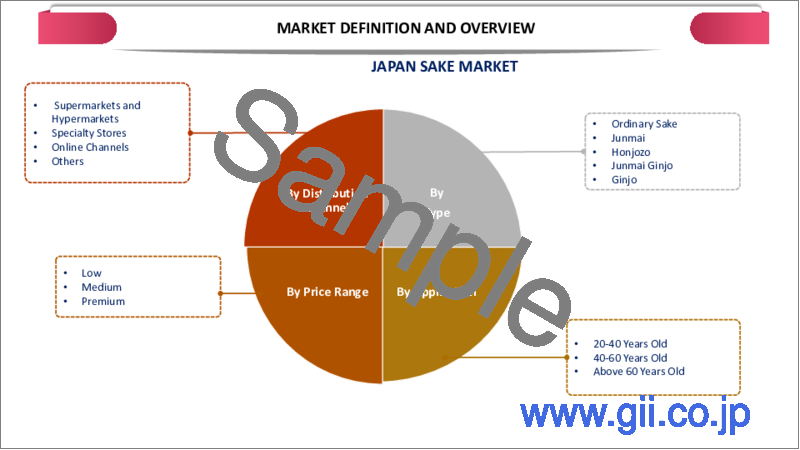|
|
市場調査レポート
商品コード
1455754
日本酒市場:2023年~2030年Japan Sake Market - 2023-2030 |
||||||
カスタマイズ可能
適宜更新あり
|
|||||||
| 日本酒市場:2023年~2030年 |
|
出版日: 2024年03月26日
発行: DataM Intelligence
ページ情報: 英文 225 Pages
納期: 即日から翌営業日
|
- 全表示
- 概要
- 目次
概要
日本酒市場は2022年に12億1,000万米ドルに達し、2030年には16億7,000万米ドルに達すると予想され、予測期間2023年~2030年のCAGRは4.1%で成長します。
日本酒は、他のアルコール飲料に比べて発酵過程が単純であるため、健康的な選択肢と見なされることがあります。これは、飲むものについてより意識的な選択をする消費者にアピールすることができます。日本酒メーカーは、より幅広い商品を提供することで、嗜好の変化に対応しています。風味やその他の基準における革新性を伴う多様化は、伝統的な日本酒に興味を示さなかったかもしれない新しい消費者を引きつけるのに役立ちます。
日本政府は、輸出促進や生産技術支援など、日本酒業界を支援するイニシアチブを実施しています。これは、日本酒生産者が世界市場で競争するのに役立ちます。日本酒造組合中央会は、2022年には日本酒の輸出が継続的に増加すると発表しました。2022年の日本酒輸出額は過去最高の475億円に達し、2021年比18%増、2013年比452%増となった。
日本酒の輸出総額は474億9,200万円に達し、2022年の前年データを上回りました。また、日本貿易統計によると、日本酒の総輸出量は過去最高の35,895 KLを達成しました。日本酒の輸出市場トップ3は香港、中国、米国です。2020年の1リットル当たりの平均輸出額は1,109円で、初めて1,000円を超えました。
ダイナミクス
新商品と革新的商品のイントロダクション
日本酒メーカーは、若い消費者や嗜好の変化にアピールするため、新しいフレーバー、スパークリングタイプ、低アルコールの日本酒で革新を図っています。例えば、平和どぶろく兜町酒造場は東京の新しい居酒屋で、店内でおつまみと一緒に作られたユニークなどぶろくフレーバーを提供しています。2023年3月現在、プレーンのほか、イチゴやホップなど約10種類のフレーバーを提供しています。
消費者の需要を満たす新商品の発売が市場拡大を支えています。日本では、市場の主要企業が、健康的な生活習慣のためにアルコール度数を下げたり、パッケージを変えたり、より洗練されたものにして顧客を惹きつけるなど、日本酒の改革を進めています。例えば、創業300年の老舗酒蔵である奥飛騨酒造は、2023年12月に新ブランドの日本酒を発売しました。新商品はアルコール度数わずか8%で、日本の低アルコール酒造の需要に応えるために開発されました。
各国規制機関による日本酒市場の新たな取り組み
日本におけるアルコール消費量、特に若年層のアルコール消費量は過去25年間、着実に減少しています。このため、政府の重要な収入源である酒類販売からの税収が減少しています。この問題に対処するため、国税庁は2022年8月に日本酒ビバ!キャンペーンを2022年8月に開始しました。この取り組みは若年層をターゲットとし、飲酒の魅力を高めることを目的としています。
日本酒ビバ!コンペは、新しいアルコール飲料のアイデアや、飲酒をより楽しく、ライフスタイルに合ったものにする方法のアイデアを若者から募集します。これは、家庭での飲酒体験を促進したり、若年層の嗜好に合わせた新しいタイプの酒を開発したりすることを含みます。
さらに2023年、日本酒焼酎協会は、欧州、アジア、アメリカでのイベント、ソムリエ協会との提携、見本市への参加などを通じて、日本酒のプロモーションを地域的、世界的に強化しました。ProWein2023への参加や、国際空港での日本酒プロモーションの強化も率先して行った。
他のアルコール飲料との高い競合
日本酒市場は、他のさまざまな代替アルコール飲料の存在によって妨げられています。ビール、ワイン、ウイスキーは、味、価格帯、飲用シーンがより多様です。このような選択肢の多さは、特に異なるアルコール飲料を探求している可能性のある若い消費者にとっては、日本酒の魅力を感じさせなくする可能性があります。日本酒は、一部の若い飲酒家には、古い世代の飲み物として認識されることもあります。
ビールや多くのRTDオプションは、自動販売機、コンビニエンスストア、スーパーマーケットで簡単に入手できます。一方、日本酒は、専門店やレストランに行く必要があり、入手しにくいかもしれません。高級な日本酒は高価だが、代替飲料の中には、より競合しやすい価格で良質なものを提供するものもあります。予算重視の消費者にとっては、これが決め手になることもあります。
目次
第1章 調査手法と調査範囲
第2章 定義と概要
第3章 エグゼクティブサマリー
第4章 市場力学
- 影響要因
- 促進要因
- 新製品と革新的製品のイントロダクション
- 規制当局による日本酒市場の新たな取り組み
- 抑制要因
- 他のアルコール飲料との高い競合
- 機会
- 影響分析
- 促進要因
第5章 産業分析
- ポーターのファイブフォース分析
- サプライチェーン分析
- 価格分析
- 規制分析
- DMIの見解
第6章 COVID-19分析
第7章 タイプ別
- 普通酒
- 純米酒
- 本醸造
- 純米吟醸
- 吟醸酒
- 純米大吟醸
第8章 年齢層別
- 20~40歳
- 40~60歳以上
- 60歳以上
第9章 価格帯別
- 低価格
- 中価格
- プレミアム
第10章 流通チャネル別
- ハイパーマーケット/スーパーマーケット
- 専門店
- オンラインチャネル
- その他
第11章 用途別
- 業務用
- 家庭用
第12章 競合情勢
- 競合シナリオ
- 市況/シェア分析
- M&A分析
第13章 企業プロファイル
- Aramasa Co, Ltd.
- 会社概要
- 製品ポートフォリオと説明
- 財務概要
- 主な発展
- ASAHI-SHUZO SAKE BREWING CO., LTD.
- HAKUTSURU SAKE BREWING CO., LTD
- Tatsuuma-Honke Brewing Co. Ltd
- Kizakura Co., Ltd.
- SAWANOTSURU co
- TAKARA SHUZO INTERNATIONAL CO., LTD.
- NIHONSAKARI CO., LTD.
- Kiku-Masamune Sake Brewing Co., Ltd.
- Miyasaka Brewing Company, Ltd.
第14章 付録
Overview
Japan Sake Market reached US$ 1.21 billion in 2022 and is expected to reach US$ 1.67 billion by 2030, growing with a CAGR of 4.1% during the forecast period 2023-2030.
Sake, perceived as having a simpler fermentation process compared to some other alcoholic beverages, is sometimes viewed as a healthier option. This can appeal to consumers who are making more conscious choices about what they drink. Sake producers are responding to changing tastes by offering a wider range of products. Diversification with innovation in flavor and other criteria helps attract new consumers who might not have been interested in traditional sake.
The Japanese government has implemented initiatives to support the sake industry, such as promoting exports and assisting with production techniques. This can help sake producers compete in a global market. The Japan Sake and Shochu Makers Association announced that there will be a continuous increase in the growth of sake exports in 2022. The Japanese sake export reached a record-high of 47.5 billion Japanese yen in 2022, an 18% increase from 2021 and a 452% jump from 2013.
The total value of sake export reached 47.492 billion JPY, surpassing the previous year's data in 2022. In addition, the total volume of sake export achieved a record-high of 35,895 KL according to Trade Statistics of Japan. The top 3 export markets for Japanese sake are Hong Kong, China, and the USA. In 2020 the average export value per liter exceeded for the first time 1000 JPY with an average of 1109 JPY per liter exported Japanese sake.
Dynamics
New and Innovative Product Introductions
Sake producers are innovating with new flavors, sparkling varieties, and lower alcohol content sakes to appeal to younger consumers and changing preferences. For instance, Heiwa Doburoku Kabutocho Brewery, a new pub in Tokyo, is serving unique doburoku flavors made in-store alongside snacks. As of March 2023, in addition to plain, the pub offers about 10 other flavors, such as strawberry and hops.
The launch of a new product meeting consumer demand supports market expansion. In Japan, major players in the market are reformulating sake by reducing its alcohol content for healthy habits, changing the packaging, and making it more sophisticated to attract customers. For instance, Okuhida Brewery, a 300-year-old sake brewery launched a new sake brand in December 2023. The new product contains just 8% alcohol and was developed to meet the demand for the low alcoholic breweries in Japan.
New Approaches Taking Place in Japan Sake Market by the National Regulatory Bodies
Alcohol consumption in Japan, particularly among young people, has been steadily decreasing for the past 25 years. This has led to a decline in tax revenue from alcohol sales, which is a significant source of income for the government. To address this issue, the National Tax Agency launched the Sake Viva! Campaign in August 2022. This initiative targets young adults and aims to make drinking more appealing to them.
The Sake Viva! competition encourages young people to submit ideas for new alcoholic beverages or ways to make drinking more enjoyable and relevant to their lifestyles. This could involve promoting at-home drinking experiences or creating new types of drinks that cater to younger tastes.
Further, in 2023, the Japan Sake and Shochu Makers Association ramped up sake promotion locally and globally through events in Europe, Asia, and the Americas, partnering with sommelier associations and attending trade shows. It also took the initiative by participating in ProWein 2023 and enhancing the promotion of sake at international airports.
High Competition from Other Alcoholic Beverages
The Japan sake market is hindered by the presence of various other alternative alcoholic beverage options in the market. Beer, wine, and whiskey offer a wider variety of tastes, price points, and drinking occasions. This abundance of choices can make sake seem less appealing, especially to younger consumers who may be exploring different alcoholic beverages. Sake can be perceived by some, younger drinkers, as an old-fashioned drink associated with older generations.
Beer and many RTD options are readily available in vending machines, convenience stores, and supermarkets. Sake, on the other hand, might be less accessible, requiring a trip to a specialized store or a restaurant. While high-end sake can be expensive, some alternative beverages offer good quality at a more competitive price. This can be a deciding factor for budget-conscious consumers.
Segment Analysis
The Japan sake market is segmented based on type, age group, price range, distribution channel and application.
Increasing Consumer Preference Towards Clean Flavor Profile of Junmai
The Japan sake market is segmented based on type into ordinary sake, junmai, honjoro, junmai ginjo, ginjo and junmain daiginjo. Junmai sake dominated the higher market share due to its clean and pure flavor profile, which appeals to a wide range of consumers. It offers a good balance of taste and affordability compared to some premium types. Junmai sake is brewed using traditional methods.
Unlike some other sake types, junmai only allows rice, water, koji mold, and yeast, adhering to stricter regulations favoured by some consumers seeking a more traditional, authentic experience. The adherence to traditional brewing techniques and the purity of ingredients often make junmai sake highly regarded among sake enthusiasts and connoisseurs. According to the report of the National Tax Agency 202o, within the premium sake category, the share of junmai sake is increasing at a rapid rate.
Junmai sake is often associated with higher quality and craftsmanship. The focus on using premium rice and meticulous brewing processes contribute to the complexity of flavors and the overall character of the sake. The attention to detail and the commitment to traditional brewing methods can result in a product that is valued for its taste and quality.
Competitive Landscape
The major Japanese players in the market include Aramasa Co, Ltd., ASAHI-SHUZO SAKE BREWING CO., LTD., HAKUTSURU SAKE BREWING CO., LTD, Tatsuuma-Honke Brewing Co. Ltd, Kizakura Co., Ltd., SAWANOTSURU co, TAKARA SHUZO INTERNATIONAL CO., LTD., NIHONSAKARI CO., LTD., Kiku-Masamune Sake Brewing Co., Ltd. and Miyasaka Brewing Company, Ltd.
COVID-19 Impact Analysis
The COVID-19 pandemic had a moderate impact on the Japan sake market. Lockdowns and restrictions on restaurants hit sake sales hard. Sake is traditionally paired with meals, and with fewer people dining out, demand dropped significantly. Travel limitations and disruptions in international trade likely caused issues for sake exports and the import of brewing ingredients.
On the other hand, as people stayed home more, some may have shifted to at-home sake enjoyment, potentially boosting retail sales. The rise of online shopping has benefited some sake breweries as consumers turned to e-commerce platforms. Overall, the pandemic likely had a negative effect on the sake industry. However, some breweries adapted by focusing on online sales and targeting at-home consumption.
By Type
- Ordinary Sake
- Junmai
- Honjoro
- Junmai Ginjo
- Ginjo
- Junmain Daiginjo
By Age Group
- 20-40 years old
- 40-60 years old
- Above 60 years old
By Price Range
- Low
- Medium
- Premium
By Distribution Channel
- Hypermarkets/Supermarkets
- Specialty Stores
- Online Channels
- Others
By Application
- Commercial Use
- Home Use
Key Developments
- In December 2023, Okuhida Brewery, a 300-year-old sake brewery launched a new sake brand. The new product contains just 8% alcohol and was developed to meet the demand for the low alcoholic breweries in Japan.
- In January 2022, Tsunan Sake Brewery launched a new sustainable sake brand called Tsunan. This exciting line is all about celebrating and supporting their local community. Tsunan sake is a true terroir experience, crafted by local people using rice and water sourced directly from the Tsunan region.
- In August 2020, Sato Sake Brewery created a brand new blue sake, Seilan. It is. The product is Ginjo sake, made with the flowers of butterfly peas with a rice polishing rate of 60%.
Why Purchase the Report?
- To visualize the Japan sake market segmentation based on type, age group, price range, distribution channel, and application, as well as understand key commercial assets and players.
- Identify commercial opportunities by analyzing trends and co-development.
- Excel data sheet with numerous data points of agriculture tires market-level with all segments.
- PDF report consists of a comprehensive analysis after exhaustive qualitative interviews and an in-depth study.
- Product mapping available as excel consisting of key products of all the major players.
The Japan's sake market report would provide approximately 78 tables, 73 figures and 225 pages.
Target Audience 2023
- Manufacturers/ Buyers
- Industry Investors/Investment Bankers
- Research Professionals
- Emerging Companies
Table of Contents
1.Methodology and Scope
- 1.1.Research Methodology
- 1.2.Research Objective and Scope of the Report
2.Definition and Overview
3.Executive Summary
- 3.1.Snippet by Type
- 3.2.Snippet by Age Group
- 3.3.Snippet by Price Range
- 3.4.Snippet by Distribution Channel
- 3.5.Snippet by Application
4.Dynamics
- 4.1.Impacting Factors
- 4.1.1.Drivers
- 4.1.1.1.New and Innovative Product Introductions
- 4.1.1.2.New Approaches Taking Place in Japan Sake Market by the National Regulatory Bodies
- 4.1.2.Restraints
- 4.1.2.1.High Competition from Other Alcoholic Beverages
- 4.1.3.Opportunity
- 4.1.4.Impact Analysis
- 4.1.1.Drivers
5.Industry Analysis
- 5.1.Porter's Five Force Analysis
- 5.2.Supply Chain Analysis
- 5.3.Pricing Analysis
- 5.4.Regulatory Analysis
- 5.5.DMI Opinion
6.COVID-19 Analysis
- 6.1.Analysis of COVID-19
- 6.1.1.Scenario Before COVID
- 6.1.2.Scenario During COVID
- 6.1.3.Scenario Post COVID
- 6.2.Pricing Dynamics Amid COVID-19
- 6.3.Demand-Supply Spectrum
- 6.4.Government Initiatives Related to the Market During Pandemic
- 6.5.Manufacturers Strategic Initiatives
- 6.6.Conclusion
7.By Type
- 7.1.Introduction
- 7.1.1.Market Size Analysis and Y-o-Y Growth Analysis (%), By Type
- 7.1.2.Market Attractiveness Index, By Type
- 7.2.Ordinary Sake
- 7.2.1.Introduction
- 7.2.2.Market Size Analysis and Y-o-Y Growth Analysis (%)
- 7.3.Junmai
- 7.4.Honjoro
- 7.5.Junmai Ginjo
- 7.6.Ginjo
- 7.7.Junmain Daiginjo
8.By Age Group
- 8.1.Introduction
- 8.1.1.Market Size Analysis and Y-o-Y Growth Analysis (%), By Age Group
- 8.1.2.Market Attractiveness Index, By Age Group
- 8.2.20-40 years old
- 8.2.1.Introduction
- 8.2.2.Market Size Analysis and Y-o-Y Growth Analysis (%)
- 8.3.40-60 years old
- 8.4.Above 60 years old
9.By Price Range
- 9.1.Introduction
- 9.1.1.Market Size Analysis and Y-o-Y Growth Analysis (%), By Price Range
- 9.1.2.Market Attractiveness Index, By Price Range
- 9.2.Low
- 9.2.1.Introduction
- 9.2.2.Market Size Analysis and Y-o-Y Growth Analysis (%)
- 9.3.Medium
- 9.4.Premium
10.By Distribution Channel
- 10.1.Introduction
- 10.1.1.Market Size Analysis and Y-o-Y Growth Analysis (%), By Distribution Channel
- 10.1.2.Market Attractiveness Index, By Distribution Channel
- 10.2.Hypermarkets/Supermarkets
- 10.2.1.Introduction
- 10.2.2.Market Size Analysis and Y-o-Y Growth Analysis (%)
- 10.3.Specialty Stores
- 10.4.Online Channels
- 10.5.Others
11.By Application
- 11.1.Introduction
- 11.1.1.Market Size Analysis and Y-o-Y Growth Analysis (%), By Application
- 11.1.2.Market Attractiveness Index, By Application
- 11.2.Commercial Use
- 11.2.1.Introduction
- 11.2.2.Market Size Analysis and Y-o-Y Growth Analysis (%)
- 11.3.Home Use
12.Competitive Landscape
- 12.1.Competitive Scenario
- 12.2.Market Positioning/Share Analysis
- 12.3.Mergers and Acquisitions Analysis
13.Company Profiles
- 13.1.Aramasa Co, Ltd.
- 13.1.1.Company Overview
- 13.1.2.Product Portfolio and Description
- 13.1.3.Financial Overview
- 13.1.4.Key Developments
- 13.2.ASAHI-SHUZO SAKE BREWING CO., LTD.
- 13.3.HAKUTSURU SAKE BREWING CO., LTD
- 13.4.Tatsuuma-Honke Brewing Co. Ltd
- 13.5.Kizakura Co., Ltd.
- 13.6.SAWANOTSURU co
- 13.7.TAKARA SHUZO INTERNATIONAL CO., LTD.
- 13.8.NIHONSAKARI CO., LTD.
- 13.9.Kiku-Masamune Sake Brewing Co., Ltd.
- 13.10.Miyasaka Brewing Company, Ltd.
LIST NOT EXHAUSTIVE
14.Appendix
- 14.1.About Us and Services
- 14.2.Contact Us






